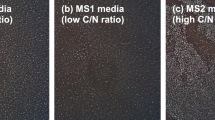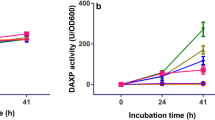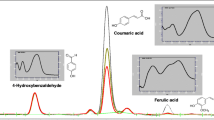Summary
During growth in the presence of fibers composed of cellulose or hemicellulose, various strains of the thermophilic soil bacterium Clostridium thermocellum and several newly isolated thermophilic anaerobic soil bacteria adhered to the fibers. Attachment occurred via a fibrous ruthenium red-staining material. C. thermocellum sporulated while attached to the fibers when the pH dropped below 6.4. It is postulated that the attachment is involved in cellulose breakdown and that C. thermocellum gaines an advantage by remaining attached to its insoluble substrates when the environment is not suitable for rapid growth. The tendency to adhere to cellulose fibers was used in the purification of thermophilic cellulolytic anaerobes.
Similar content being viewed by others
References
Ait N, Creuzet N, Forget P (1979) Partial purification of cellulase from Clostridium thermocellum. Microbiology 113:399–402
Akin DE (1976) Ultrastructure of rumen bacterial attachment to forage cell walls. Appl Environ Microbiol 31:562–568
Akin DE (1980) Evaluation by electron microscopy and anaerobic culture of types of rumen bacteria associated with digestion of forage cell walls. Appl Environ Microbiol 39:242–252
Bayer EA, Kenig R, Lamed R (1983) Adherence of Clostridium thermocellum to cellulose. J Bacteriol 156:818–827
Berg B, van Hofsten B, Petterson G (1972) Electron microscopic observations on the degradation of cellulose fibers by Cellvibrio fulvus and Sporocytophaga myxococcoides. J Appl Bacteriol 35:215–220
Carreira LH, Liungdahl LG (1983) Ethanol from biomass. In: Wise D (ed) Organic chemicals from biomass. Addison-Wesley Publishing Co., Massachusets (in press)
Dinsdale D, Morris EJ, Bacon JSD (1978) Electron microscopy of the microbial populations present and their modes of attack on various cellulosic substrates undergoing digestion in the sheep rumen. Appl Environ Microbiol 36:160–168
Gilbert JG, Tsao GT (1983) Interaction between solid substrate and cellulase enzymes in cellulose hydrolysis. Ann Reports on Fermentation Processes 6:323–358
Lamed R, Stetter E, Bayer EA (1983) Characterization of a cellulose binding cellulase-containing complex in Clostridium thermocellum. J Bacteriol 156:828–836
Lamed R, Setter E, Kenig R, Bayer EA (1983) The cellulosome, a discret cell surface organelle of Clostridium thermocellum which exhibits separate antigenic cellulose-binding and various cellulolytic activities. Biotechnol Bioeng Symp 13 (in press)
Latham MJ, Brooker BE, Pettipher GL, Harris PJ (1978) Adhesion of Bacteroides succinogenes in pure culture and in the presence of Ruminococcus flavefaciens to cell walls in leaves of perennial ryegrass (Lolium perenne). Appl Environ Microbiol 35:1166–1173
Ljungdahl LG, Peterson B, Eriksson KE, Wiegel J (1983) A yellow affinity substance involved in the cellulolytic system of Clostridium thermocellum. Current Microbiology 9:195–200
McCowan RP, Cheng KJ, Costerton JW (1980) Adherent bacterial populations on the bovine rumen wall: Distribution patterns of adherent bacteria. Appl Environ Microbiol 39:233–241
McDowell EM, Trump BF (1976) Histologic fixatives suitable for diagnostic light and electron microscopy. Arch Pathol Lab Med 100:405–414
Millner PD, Ericson KE, Marsh PB (1982) Bacteria on closed-boll and commercially harvested cotton. Appl Environ Microbiol 44:355–362
Minato H, Endo A, Higuchi M, Ootomo Y, Uemura T (1966) Ecological treatise on the rumen fermentation. I. The fractionation of bacteria attached to the rumen digest solids. J Gen Appl Microbiol 12:39–52
Ng TK, Zeikus JG (1981) Comparison of extracellular cellulase activities of Clostridium thermocellum LQR1 and Trichoderma reesei QM414. Appl Environ Microbiol 42:231–240
Patterson H, Irvin R, Costerton JW, Cheng KJ (1975) Ultrastructure and adhesion properties of Ruminococcus albus. J Bacteriol 122:278–287
Quinn LA (1949) Isolation and morphological studies of a thermophilic cellulose digesting organism. Ph.D. Thesis, Purdue University, Lafayette, IN
Reynolds ES (1963) The use of lead citrate at high pH as an electron opaque stain in electron microscopy. J Cell Biol 17:208–212
Spurr AR (1969) A low-viscosity epoxy resin embedding medium for electron microscopy. J Ultrastruct Res 26:31–43
Wiegel J (1982) Ethanol from cellulose. Experientia 38:151–155
Wiegel J, Ljungdahl LG (1979) Ethanol as fermentation product of extreme thermophilic, anaerobic bacteria. In: Dellweg H (ed) Anaerobe Fermentation — Klassische Prozesse mit neuen Aussichten. Verlag Versuchs- und Lehranstalt für Spiritusfabrikation und Fermentationstechnologie im Institut für Gärungsgewerbe und Biotechnologie, Berlin, pp 117–127
Wiegel J, Ljungdahl LG (1981) Thermoanaerobacter ethanolicus gen. nov., spec. nov. a new extreme thermophilic, anaerobic bacterium. Arch Microbiol 128:343–348
Wiegel J, Puls J (1983) Production of ethanol from hemicelluloses of hardwoods and annual plants. In: Strub A, Chartier P, Schleser G (eds) Energy from biomass, 2nd E.C. Conference. Applied Science Publishers, London New York, pp 863–867
Wiegel J, Ljungdahl LG, Rawson JR (1979) Isolation from soil and properties of the extreme thermophile Clostridium thermohydrosulfuricum. J Bacteriol 139:800–810
Wiegel J, Carreira L, Mothershed C, Puls J (1983) Production of ethanol from biopolymers by anaerobic, thermophilic and extreme thermophilic bacteria: II. Thermoanaerobacter ethanolicus JW200 and its mutant in batch culture and resting cell experiments. Biotechnol Bioeng Symp 13 (in press)
Author information
Authors and Affiliations
Rights and permissions
About this article
Cite this article
Wiegel, J., Dykstra, M. Clostridium thermocellum: Adhesion and sporulation while adhered to cellulose and hemicellulose. Appl Microbiol Biotechnol 20, 59–65 (1984). https://doi.org/10.1007/BF00254647
Received:
Issue Date:
DOI: https://doi.org/10.1007/BF00254647




